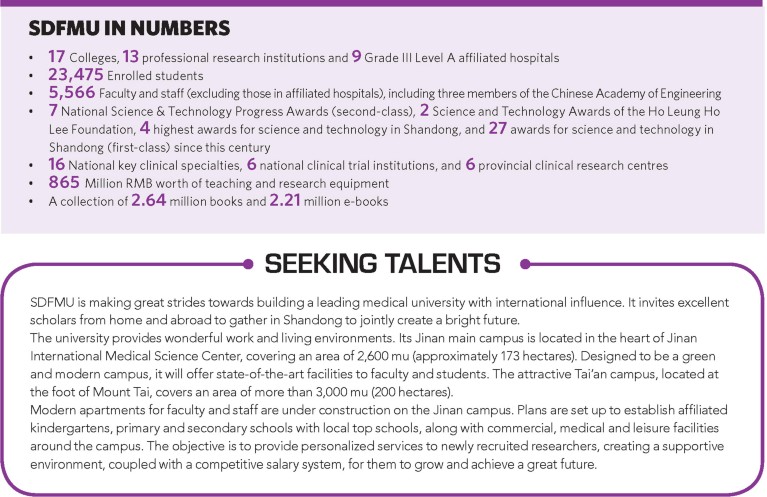
Credit: Shandong first medical university
Housing a World Health Organization Collaborating Centre, Shandong First Medical University (SDFMU) has quickly become a leader in disease research and treatment. With innovative approaches to skin, parasitic, and rare diseases, it sets standards in many prevention and control methods.
Making huge steps in the early diagnosis and treatment of tumours, and radiation protection, the university is looking to spread its successful experience to developing countries in Africa and Asia, broadly benefiting human health.
The 2019 merger of Taishan Medical University, Shandong Academy of Medical Sciences, and several local hospitals in Shandong saw the establishment of SDFMU. With the main campus in the historic and cultural city of Jinan, capital of Shandong province, the university aims to make a big impact on higher medical education in Shandong and the nation. By integrating quality research, education, and clinical resources, it seeks to build a novel training system for innovative medical personnel, and become a first-class applied research university.
“We strive to build the largest medical research centre in the province within five years, and be ranked among the nation’s top 10 medical universities within 10 years, with some world-class academic programmes,” said Guang Ning, the president of SDFMU. “In line with the ‘Healthy China’ strategy, and the provincial strategy to integrate science and education, we want to become a model site for science-education integration, industry-university-research partnerships, and for system innovation.”
Medical research and disease prevention
Focusing on cutting-edge research in medicine and life sciences, SDFMU researchers are engaged in basic and applied research, targeting major diseases that threaten human health. The university has strong foundations in ophthalmic keratopathy, endocrine and metabolic diseases, leprosy, and tumour radiotherapy. Housing a number of advanced research platforms, including ministerial and provincial key laboratories, it has achieved innovative research results, bringing significant social and economic benefits.
Researchers from Shandong were pioneer in eliminating four infectious diseases that were major health threats in China in the last century, including leishmaniasis, filariasis, malaria, and leprosy. The work on these four diseases was lauded as by the World Health Organization (WHO).
Clinical service
With four general hospitals and five specialty hospitals, SDFMU has strong clinical service capacity. One of its general hospitals is ranked 16th in comprehensive strengths among hospitals of East China in the best hospital ranking produced by Fudan University. Two specialty hospitals were listed among the national top 10 in terms of Fudan’s ranking for reputation of clinical specialties. With the construction of the Proton Therapy Center at Shandong Cancer Hospital well underway, the university is to further enhance its research, teaching, and residency training capacities.
Talent training
As a pilot site for a national training programme of outstanding physicians, SDFMU has a strong clinical medicine programme, ranking among the global top 1% according to the Essential Science Indicators ranking. With a focus on medical sciences, the university has set up diverse programmes covering humanities, law, natural science and engineering, management, and education, featuring 44 undergraduate programmes.
With talent cultivation as a core mission, the university has established a comprehensive, multilevel training system. Its main campus in Jinan employs an elite education model, aiming to produce medical talents with solid academic backgrounds, superb medical skills, an innovative spirit, and a global vision. Its people are capable of leading future medical development, through joint training with renowned global universities.
The Tai’an campus emphasizes specialty education, focusing on cultivating talents with strong applied skills to meet local demand for medical services, and for professionals in fields short of capacity. Great efforts are made to enhance strengths, and develop medical technology and nutrition and health related subjects by encouraging deep integration of medical science with other disciplines, with the goal to make the university a key base providing much needed skillful medical professionals for Shandong.
International cooperation
Internationalization is part of the university development strategy, leading to partnerships with universities and medical institutions in 30-plus countries, such as Britain, the United States and Australia. In the past five years, the university has carried out more than 100 international cooperation projects, including those under the China-UK Global Health Support Programme, sponsored by the Ministry of Commerce, and the National Key Research and Development Plan of the Ministry of Science and Technology (MOST).
Since 2004, it has enrolled undergraduate and graduate international students from more than 20 countries and regions. It has also organized several training classes on prevention and treatment of common infectious diseases in developing countries, part of a MOST programme.



